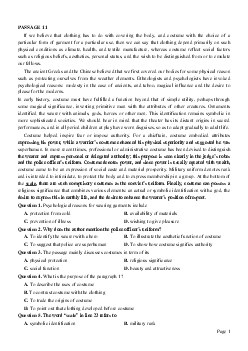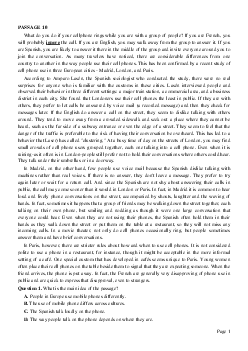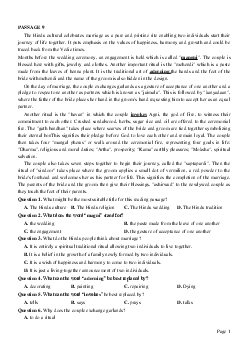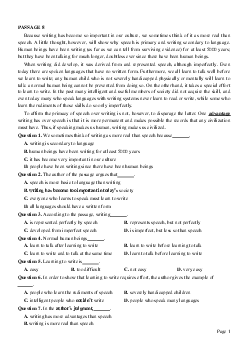


Preview text:
PASSAGE 29
Every summer, three billion birds of 300 species migrate from northern Africa to Europe and Asia. In
the winter, they return to Africa’s warmer shores. The bird’s migration is long and difficult, and some of
the animals inevitably die during each trip. However, it is not this twice-a-year journey that poses the
greatest risk to these animals. The main threat to the birds’ survival comes from human hunters.
All over the Mediterranean millions of migrating birds are killed for food profit, and sport every year.
As a result, bird populations are dropping all over the region. In nations along the Mediterranean, many
migratory birds are illegally trapped or shot. In addition to traps, hunters also use electronic calls to catch
birds. This tool, which a hunter can operate from a cell phone, mimics bird sounds and is so effective in
attracting the animals that in some countries, bird populations have plummeted. Some hunters also use
nets to capture birds as they fly close to the sea. The nets are high-going from ground level to just over 3
meters – and invisible to the birds, allowing hunters to trap hundred birds at a time.
Countries all over the Mediterranean are aware that bird populations are susceptible, and many are
working to address this problem by making migratory hunting illegal in some countries or strictly
controlling it in others. More nature-protection groups are also making sure that laws are obeyed. The
organization WWF Italy, for example, works with volunteers to stop poachers and destroy birdsong devices that attract birds.
Question 1. What is the passage mainly about?
A. problems caused by migrating birds
B. how birds are being hunted worldwide
C. how tourism is causing a drop in bird population
D. dangers to migrating birds in the Mediterranean
Question 2. The purpose of the first paragraph is to describe .
A. how many birds travel large distances to and from Africa
B. why some birds migrate while others do not
C. why bird numbers are starting to drop in the Mediterranean
D. how some migrating birds cannot endure the journeys
Question 3. What is the biggest danger to migrating birds?
A. crossing the Sahara Desert B. lack of food
C. being hunted by humans
D. storms in the Mediterranean
Question 4. Which of these is NOT mentioned as a way of attracting and catching birds? A. traps B. food offering C. nets D. bird calls
Question 5. The word “susceptible” in paragraph 3 is closest in meaning to . A. rescued B. vulnerable C. crowded D. preserved Page 1 ĐÁP ÁN 1-D 2-C 3-C 4-B 5-B
LỜI GIẢI CHI TIẾT Question 1: D Ý chính của bài là gì?
A. vấn đề gây ra bởi chim di cư
B. chim đang bị săn bắn trên toàn thế giới như thế nào
C. làm thế nào du lịch gây ra sự sụt giảm dân số chim
D. mối nguy hiểm đối với các loài chim di cư ở Địa Trung Hải
=> Dẫn chứng: All over the Mediterranean millions of migrating birds are killed for food profit, and sport every year.
Dịch: Trên khắp Địa Trung Hải, hàng triệu con chim di cư bị giết vì lợi nhuận thực phẩm và thể thao mỗi năm. Question 2: C
Mục đích của đoạn đầu tiên là để mô tả .
A. có bao nhiêu con chim di chuyển khoảng cách lớn đến và từ Châu Phi
B. tại sao một số loài chim di cư trong khi những con khác không
C. tại sao số lượng chim bắt đầu giảm ở Địa Trung Hải
D. làm thế nào một số loài chim di cư không thể chịu đựng được cuộc hành trình
Dẫn chứng: As a result, bird populations are dropping all over the region. In nations along the
Mediterranean, many migratory birds are illegally trapped or shot.
Dịch: Kết quả là, quần thể chim đang giảm trên toàn khu vực. Ở các quốc gia dọc Địa Trung Hải, nhiều
loài chim di cư bị nhốt hoặc bắn bất hợp pháp. Question 3: C
Mối nguy hiểm lớn nhất đối với các loài chim di cư là gì? A. băng qua sa mạc Sahara B. thiếu thức ăn
C. bị con người săn đuổi
D. bão ở Địa Trung Hải
=> Dẫn chứng: The main threat to the birds’ survival comes from human hunters.
Dịch: Mối đe dọa chính đối với sự sống còn của loài chim đến từ các người thợ săn. Question 4: B
Điều nào trong số này KHÔNG được đề cập như một cách thu hút và bắt chim? A. bẫy B. cung cấp thực phẩm C. lưới D. chim gọi
=> Dẫn chứng: In addition to traps, hunters also use electronic calls to catch birds. This tool, which a
hunter can operate from a cell phone, mimics bird sounds and is so effective in attracting the animals that
in some countries, bird populations have plummeted. Some hunters also use nets to capture birds as they
fly close to the sea. The nets are high-going from ground level to just over 3 meters – and invisible to the
birds, allowing hunters to trap hundred birds at a time. Page 2
Dịch: Ngoài bẫy, thợ săn còn sử dụng các cuộc gọi điện tử để bắt chim. Công cụ này, mà một thợ săn có
thể hoạt động từ điện thoại di động, bắt chước âm thanh của chim và rất hiệu quả trong việc thu hút các
loài động vật mà ở một số quốc gia, quần thể chim đã giảm mạnh. Một số thợ săn cũng sử dụng lưới để
bắt chim khi chúng bay sát biển. Lưới có chiều cao từ mặt đất đến chỉ hơn 3 mét - và vô hình với những
con chim, cho phép thợ săn bẫy hàng trăm con chim cùng một lúc. Question 5: B
Từ “nhạy cảm” trong đoạn 3 có nghĩa gần nhất với . A. giải cứu B. dễ bị tổn thương C. đông đúc D. được bảo tồn => Đáp án B Page 3




